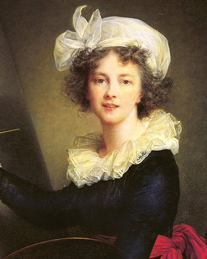엘리자베스 비제 르브룅(Louise Élisabeth Vigée Le Brun)FOLLOW
1755년04월16일 프랑스 파리 출생 - 1842년03월30일

추가정보
Versailles to paint Marie Antoinette. So pleased was the queen that during a period of six years, Vigee-Le Brun would paint more than thirty portraits of the queen and her family.
On 12 February 1780, Vigee-Le Brun gave birth to a daughter Jeanne Julie Louise, whom she called 'Julie'.
Charles Alexandre de Calonne, by ?isabeth Vig?-Le BrunIn 1781 she and her husband toured Flanders and the Netherlands where seeing the works of the Flemish masters inspired her to try new techniques. There, she painted portraits of some of the nobility, including the Prince of Nassau.
On 31 May 1783, Vig? Le Brun was accepted as a member of France's Acad?ie Royale de Peinture et de Sculpture. She submitted numerous portraits along with an allegorical history painting which she considered her morceau de reception - La Paix qui ramene l'Abundance, "Peace Bringing In Prosperity" The Academy did not place her work within an academic category of type of painting -- history or portraiture.
Ad?a?e Labille-Guiard also was admitted on the same day. The admission of Vig?-Le Brun was opposed on the grounds that her husband was an art dealer, but eventually they were overruled by an order from Louis XVI because Marie-Antoinette put considerable pressure on her husband on behalf of her painter. The admission of more than one woman on the same day to the Acad?ie encouraged comparisons among the works of the women instead of one woman contrasted with the existing members, who were men.
In 1789, she was succeeded as court painter to Marie Antoinette by Alexander Kucharsky
After the arrest of the royal family during the French Revolution Vig?-Le Brun fled France with her young daughter Julie. She lived and worked for some years in Italy, Austria, and Russia, where her experience in dealing with an aristocratic client?e was still useful. In Rome, her paintings met with great critical acclaim and she was elected to the Roman Accademia di San Luca.
In Russia, she was received by the nobility and painted numerous members of the family of Catherine the Great. While there, Vig?-Le Brun was made a member of the Academy of Fine Arts of Saint Petersburg. Much to Vig?-Le Brun's dismay, Julie married a Russian nobleman.
She was welcomed back to France during the reign of Emperor Napoleon I. Much in demand by the ?ite of Europe, she visited England at the beginning of the nineteenth century and painted the portrait of several British notables including Lord Byron. In 1807 she traveled to Switzerland and was made an honorary member of the Soci??pour l'Avancement des Beaux-Arts of Geneva.
Self-portrait, painted at Florence, 1790She published her memoirs in 1835 and 1837, which provide an interesting view of the training of artists at the end of the period dominated by royal academies. Her portrait of fellow neoclassical painter, Hubert Robert, is in Paris at Musee National du Louvre.
Still very active with her painting in her fifties, she purchased a house in Louveciennes, ?e-de-France, and lived there until the house was seized by the Prussian Army during the war in 1814. She stayed in Paris until her death on 30 March 1842 when her body was taken back to Louveciennes and buried in the cemetery near her old home.
Her tombstone epitaph states "Ici, enfin, je repose?quot; (Here, at last, I rest?.
Vig?-Le Brun left a legacy of 660 portraits and 200 landscapes. In addition to private collections, her works may be found at major museums, such as Hermitage Museum, London's National Gallery, in Europe and the United States.
